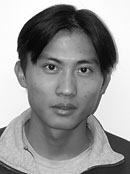UC Berkeley Press Release
National magazines laud young UC Berkeley innovators
BERKELEY – They may not have Nobel Prizes - yet - but five young University of California, Berkeley, researchers and two recent alumni have been flagged by popular national science magazines as people to watch.
Popular Science included two young UC Berkeley faculty members - assistant professor Sheila Patek of integrative biology and professor Kurt Cuffey of geography and of earth and planetary science - in its third annual "Brilliant 10" list published in the October issue. According to the magazine, all 10 scientists are united by their "passion, intellectual curiosity and ... quirky sensibility."
Also this month, MIT Technology Review named two UC Berkeley researchers - nanotechnologist Yi Cui and computer science assistant professor James O'Brien - and two former UC Berkeley graduate students to its fourth annual list of the "Top 100 Innovators" under the age of 35. They "represent the diversity of those using technology to transform the world around us," according to the publication.
And National Geographic Magazine inaugurated last month an "emerging explorers" program, recognizing Tyrone Hayes, professor of integrative biology, as one of its first nine "visionary explorers." The Emerging Explorers Program, it said, "recognizes and supports uniquely gifted and inspiring adventurers, scientists, photographers and storytellers who are making a significant contribution to world knowledge through exploration while still early in their careers." The honor comes with an award of $10,000 to assist with research and to aid further exploration.
About the honorees:
 Sheila Patek (Photo courtesy John B. Carnett/Popular Science) |
 Kurt Cuffey (Photo by Don Bain/UC Berkeley) |
 Yi Cui |
 James O'Brien |
 Tyrone Hayes (Photo by Muy Ngaou, courtesy of National Geographic) |
The two former graduate students on MIT Technology Review's list of the "Top 100 Innovators" are Marcel Bruchez, co-founder and principal staff scientist of Quantum Dot Corp. of Hayward, and Michael Helmbrecht, founder and president of Iris AO Inc. of Berkeley.
Bruchez, 31, was a graduate student in the chemistry department at UC Berkeley six years ago when he discovered the ability of quantum dots - glowing particles just nanometers wide - to tag proteins inside cells. Within months, he had co-founded Quantum Dot to market the new imaging tool to biologists and drug developers seeking a more detailed picture of molecular events. It is one of the first commercial applications of nanotechnology. Bruchez obtained his Ph.D. in chemistry from UC Berkeley in 1998.
Helmbrecht, 34, is one of the world's few experts in the design of deformable mirror MEMS - microscopic deformable mirrors modeled after the adaptive optics that sharpen the images of the world's state-of-the-art optical telescopes. Microscopic adaptive optics mounted on computer chips can perform image correction for medical imaging, surveillance and other applications. He worked as a graduate student researcher and then a research associate at the Berkeley Sensor & Actuator Center from 1995 to 2002, receiving his Ph.D. from UC Berkeley's Department of Electrical Engineering and Computer Science in 2002.

